Abstract
This study investigated the relation between impaired anticipatory postural adjustments and bradykinesia in Parkinson's disease. Patients with Parkinson's disease and age matched controls stood on a platform. In one series of experiments, they performed fast, discrete shoulder flexion or extension movements. In another series, they were required to press a trigger with the right thumb and thus to release a load that was suspended from a bar which they were holding in front of them in extended arms. One more series included catching a load on the same bar. Anticipatory changes in the activity of postural muscles before fast voluntary movements occurred in patients and controls although the patients showed higher variability of anticipatory patterns. During load dropping and catching, control subjects had reproducible, although smaller, anticipatory changes in postural muscle activity. Such changes were absent in all but one patient. Two sources of these postural perturbations were analysed. The anticipatory postural adjustments in different muscle groups may counteract perturbations of different origin. The distal to proximal sequencing of joint involvement in postural reactions may be related to different reference points and working points associated with these tasks compared with reaching limb movements. The deficit in anticipatory postural adjustments in Parkinson's disease is likely to be unrelated to bradykinesia and is more likely to reflect the deficits in the basic processes of preparation and initiation of a motor act.
Full text
PDF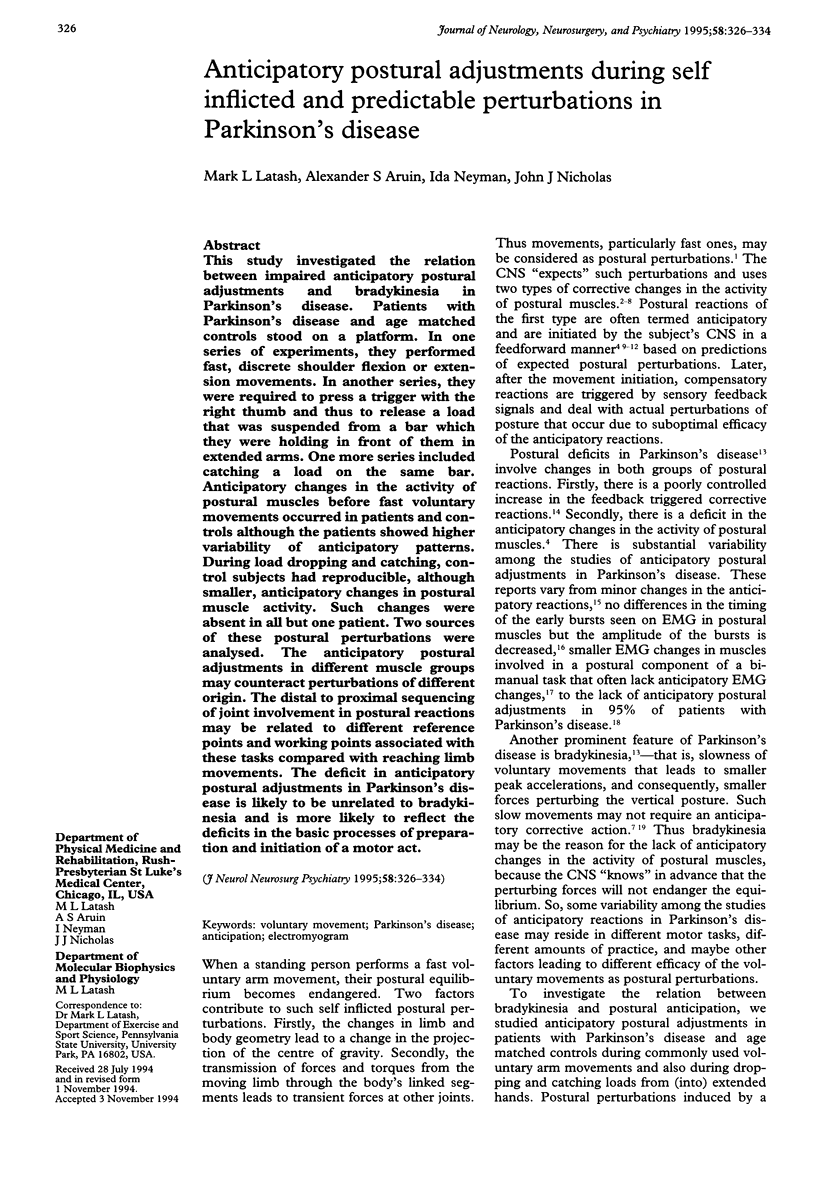

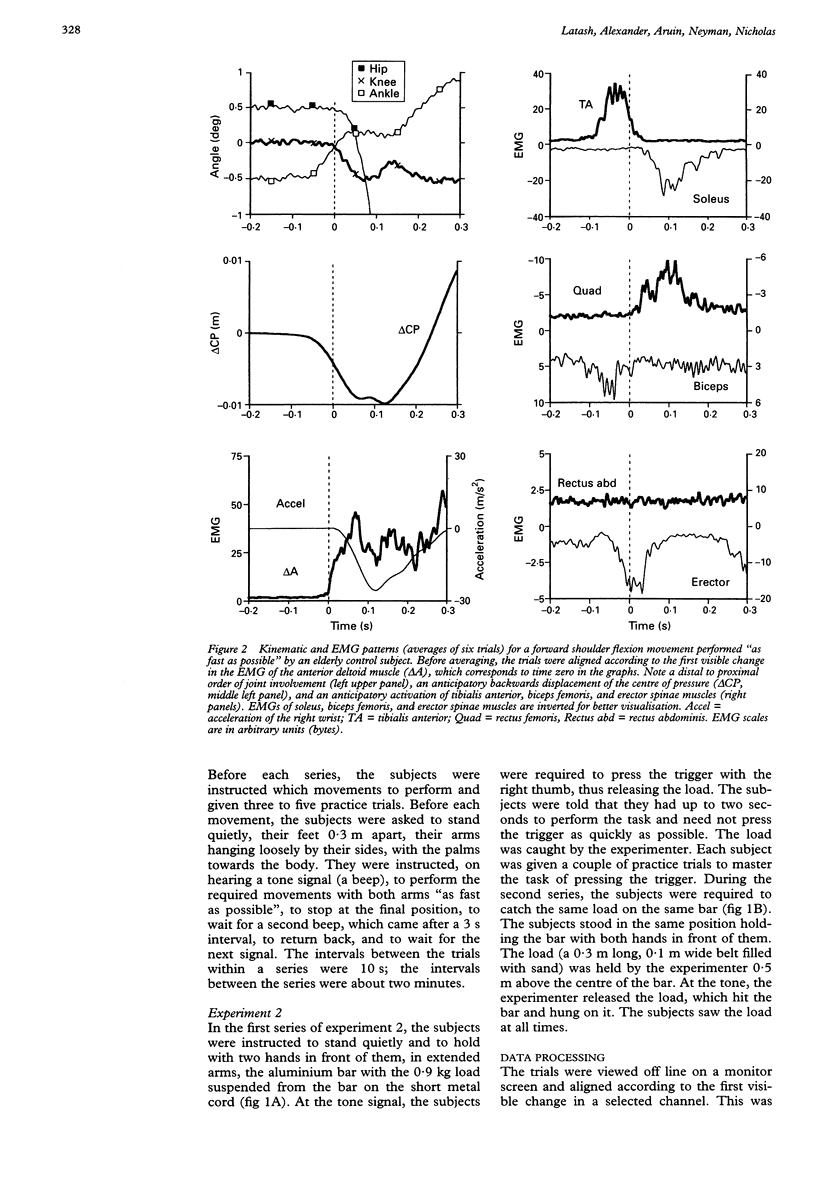
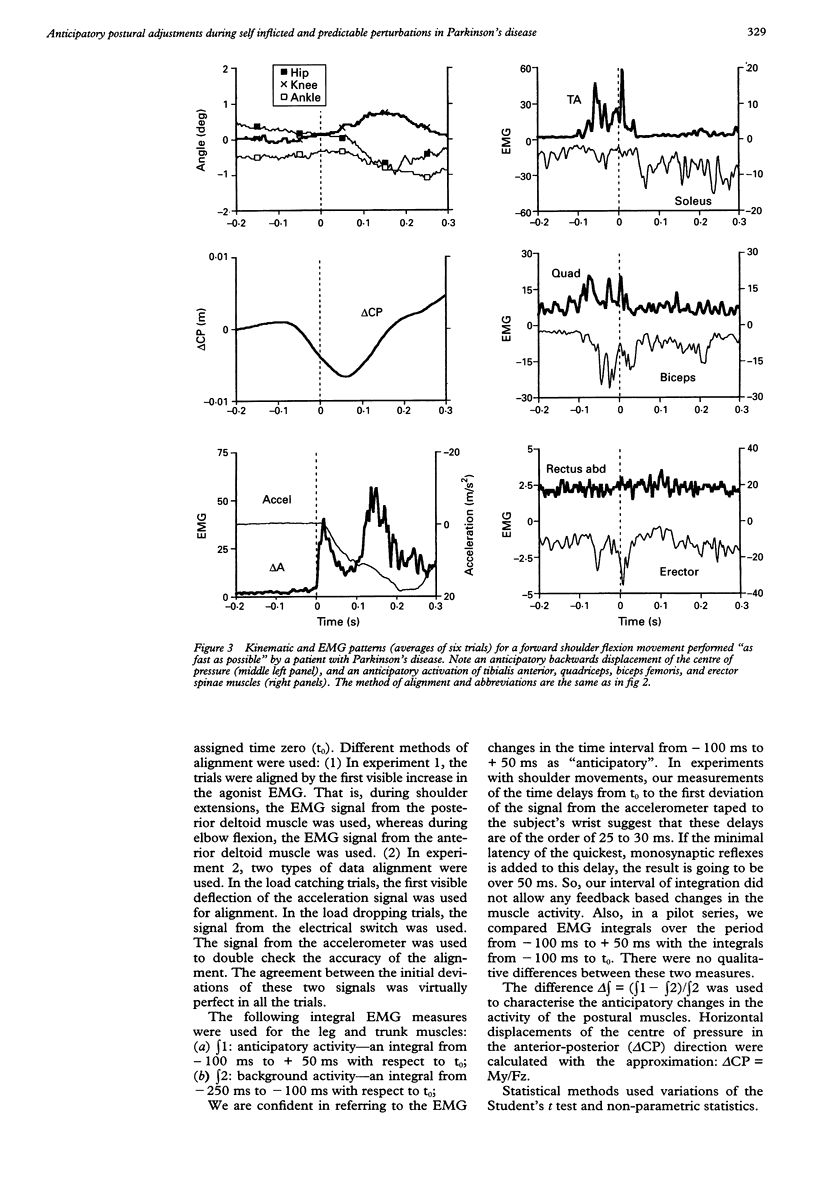
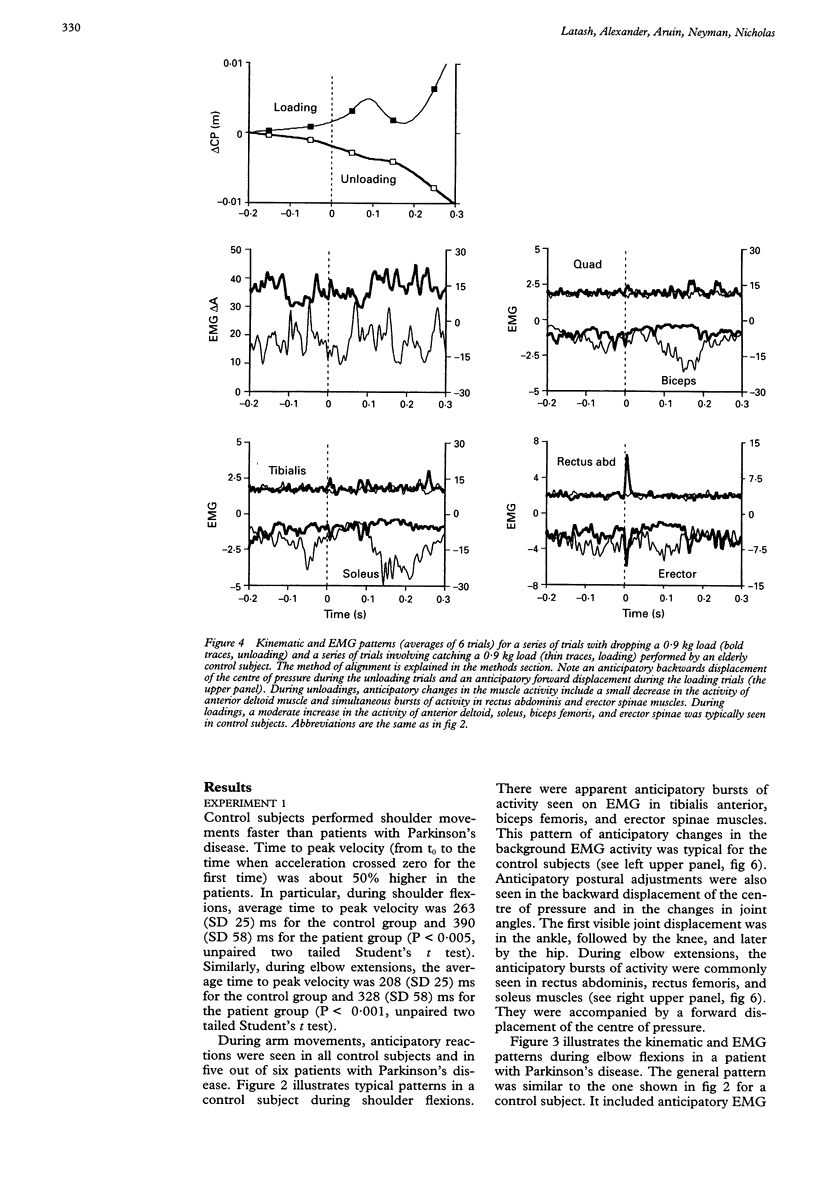
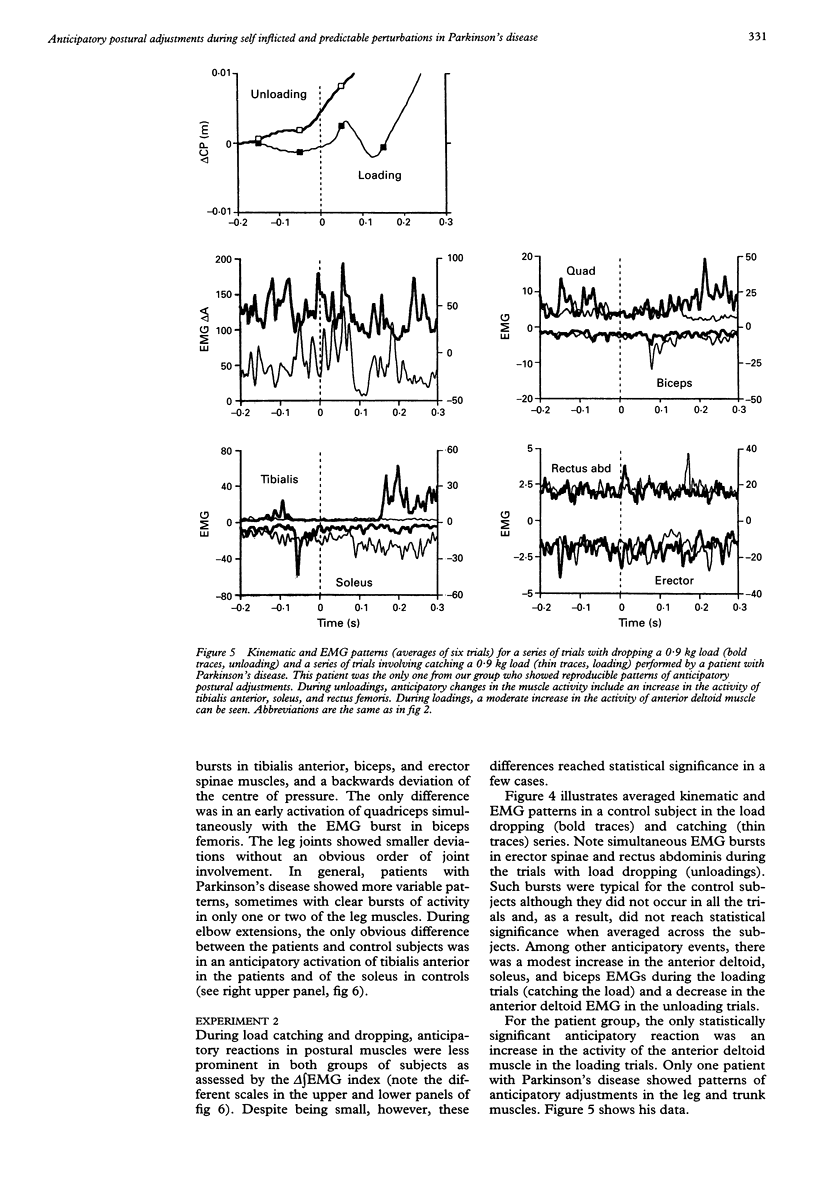
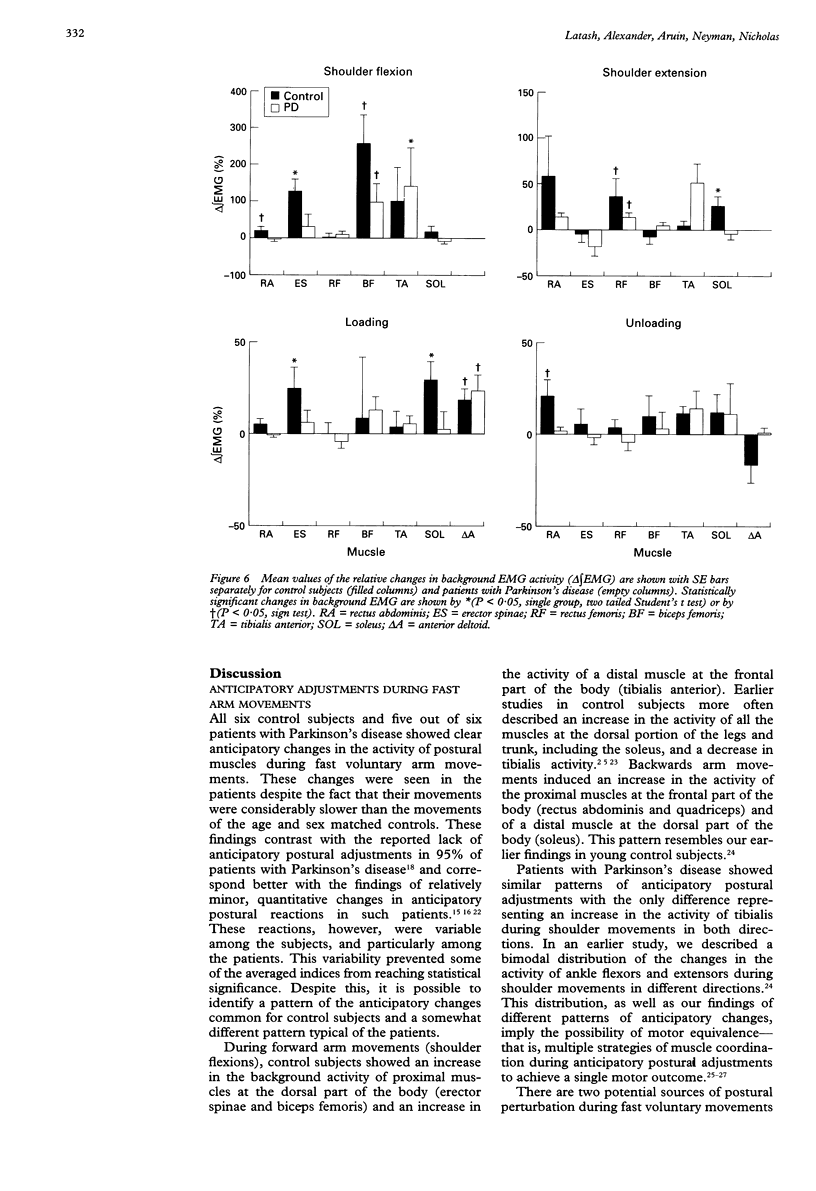
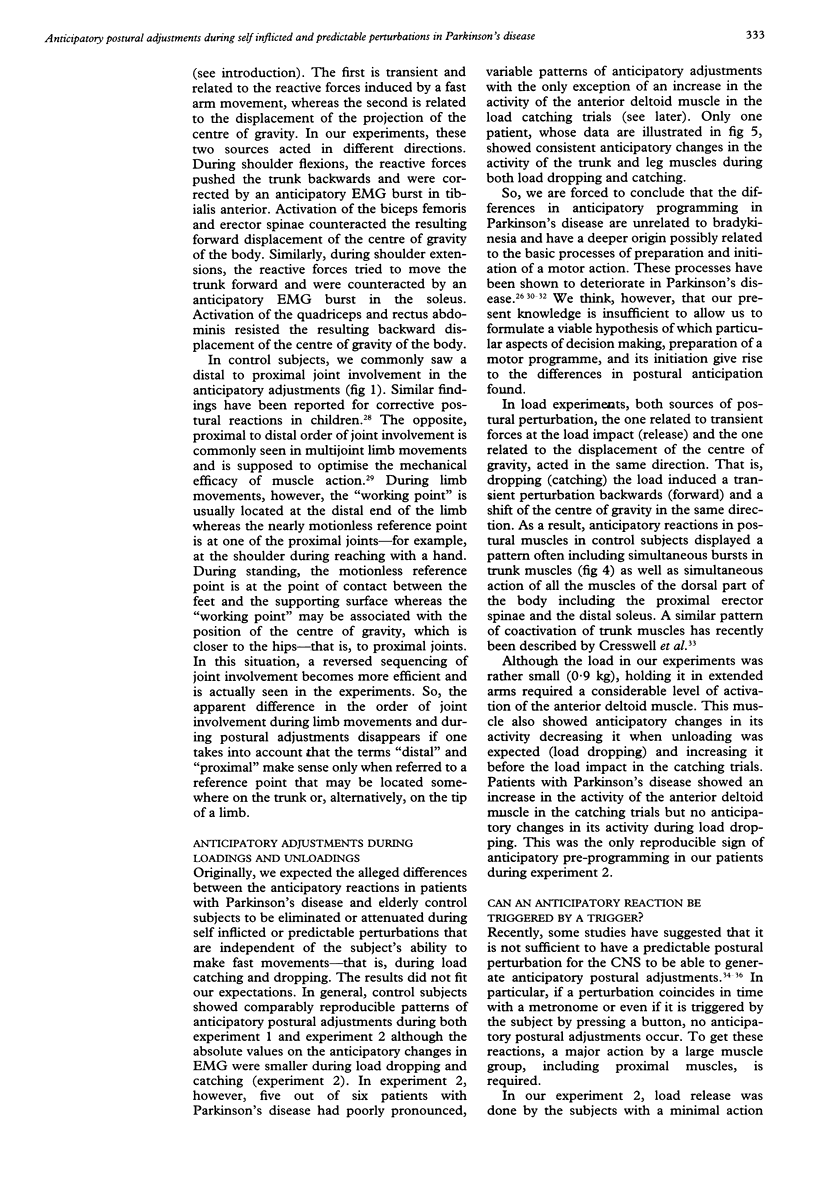
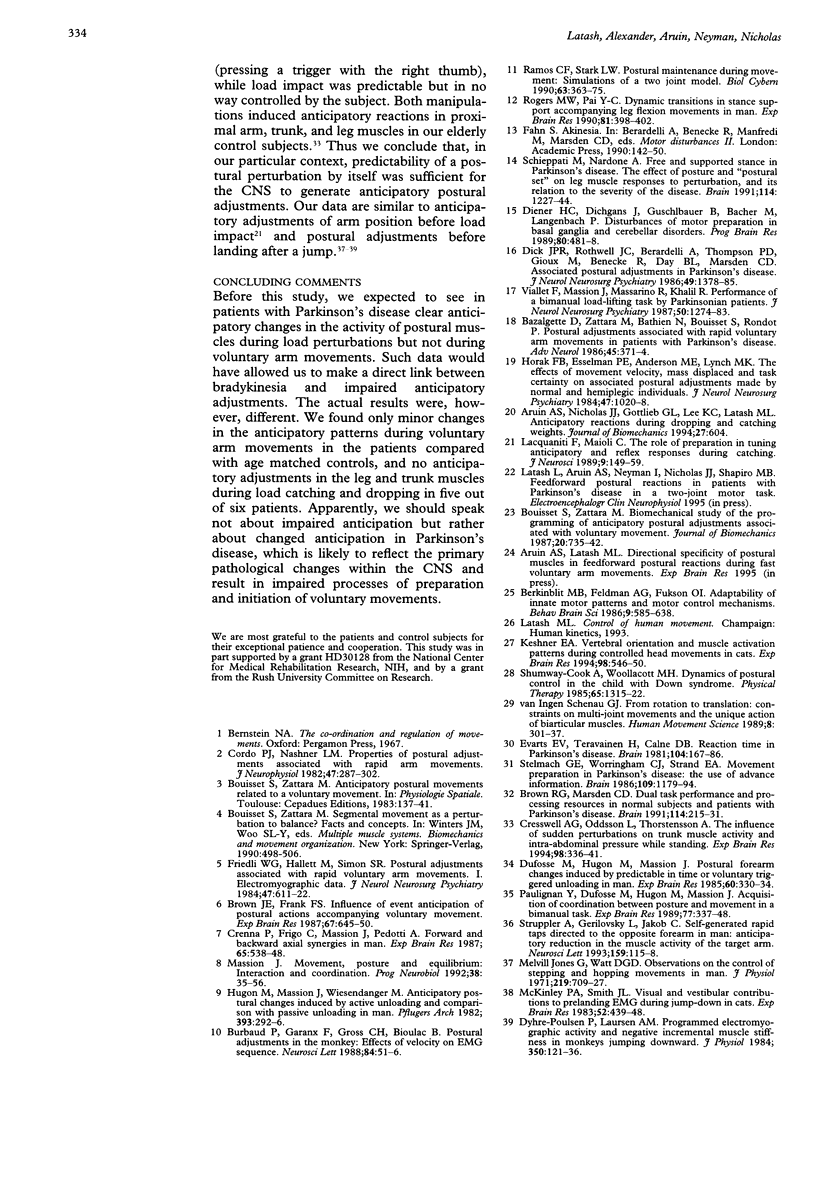
Images in this article
Selected References
These references are in PubMed. This may not be the complete list of references from this article.
- Bazalgette D., Zattara M., Bathien N., Bouisset S., Rondot P. Postural adjustments associated with rapid voluntary arm movements in patients with Parkinson's disease. Adv Neurol. 1987;45:371–374. [PubMed] [Google Scholar]
- Bouisset S., Zattara M. Biomechanical study of the programming of anticipatory postural adjustments associated with voluntary movement. J Biomech. 1987;20(8):735–742. doi: 10.1016/0021-9290(87)90052-2. [DOI] [PubMed] [Google Scholar]
- Brown J. E., Frank J. S. Influence of event anticipation on postural actions accompanying voluntary movement. Exp Brain Res. 1987;67(3):645–650. doi: 10.1007/BF00247295. [DOI] [PubMed] [Google Scholar]
- Brown R. G., Marsden C. D. Dual task performance and processing resources in normal subjects and patients with Parkinson's disease. Brain. 1991 Feb;114(Pt 1A):215–231. [PubMed] [Google Scholar]
- Burbaud P., Garanx F., Gross C., Bioulac B. Postural adjustments in the monkey: effects of velocity on EMG sequence. Neurosci Lett. 1988 Jan 11;84(1):51–56. doi: 10.1016/0304-3940(88)90336-9. [DOI] [PubMed] [Google Scholar]
- Cordo P. J., Nashner L. M. Properties of postural adjustments associated with rapid arm movements. J Neurophysiol. 1982 Feb;47(2):287–302. doi: 10.1152/jn.1982.47.2.287. [DOI] [PubMed] [Google Scholar]
- Crenna P., Frigo C., Massion J., Pedotti A. Forward and backward axial synergies in man. Exp Brain Res. 1987;65(3):538–548. doi: 10.1007/BF00235977. [DOI] [PubMed] [Google Scholar]
- Cresswell A. G., Oddsson L., Thorstensson A. The influence of sudden perturbations on trunk muscle activity and intra-abdominal pressure while standing. Exp Brain Res. 1994;98(2):336–341. doi: 10.1007/BF00228421. [DOI] [PubMed] [Google Scholar]
- Dick J. P., Rothwell J. C., Berardelli A., Thompson P. D., Gioux M., Benecke R., Day B. L., Marsden C. D. Associated postural adjustments in Parkinson's disease. J Neurol Neurosurg Psychiatry. 1986 Dec;49(12):1378–1385. doi: 10.1136/jnnp.49.12.1378. [DOI] [PMC free article] [PubMed] [Google Scholar]
- Diener H. C., Dichgans J., Guschlbauer B., Bacher M., Langenbach P. Disturbances of motor preparation in basal ganglia and cerebellar disorders. Prog Brain Res. 1989;80:481–480. doi: 10.1016/s0079-6123(08)62247-5. [DOI] [PubMed] [Google Scholar]
- Dufossé M., Hugon M., Massion J. Postural forearm changes induced by predictable in time or voluntary triggered unloading in man. Exp Brain Res. 1985;60(2):330–334. doi: 10.1007/BF00235928. [DOI] [PubMed] [Google Scholar]
- Dyhre-Poulsen P., Laursen A. M. Programmed electromyographic activity and negative incremental muscle stiffness in monkeys jumping downward. J Physiol. 1984 May;350:121–136. doi: 10.1113/jphysiol.1984.sp015192. [DOI] [PMC free article] [PubMed] [Google Scholar]
- Evarts E. V., Teräväinen H., Calne D. B. Reaction time in Parkinson's disease. Brain. 1981 Mar;104(Pt 1):167–186. doi: 10.1093/brain/104.1.167. [DOI] [PubMed] [Google Scholar]
- Friedli W. G., Hallett M., Simon S. R. Postural adjustments associated with rapid voluntary arm movements 1. Electromyographic data. J Neurol Neurosurg Psychiatry. 1984 Jun;47(6):611–622. doi: 10.1136/jnnp.47.6.611. [DOI] [PMC free article] [PubMed] [Google Scholar]
- Horak F. B., Esselman P., Anderson M. E., Lynch M. K. The effects of movement velocity, mass displaced, and task certainty on associated postural adjustments made by normal and hemiplegic individuals. J Neurol Neurosurg Psychiatry. 1984 Sep;47(9):1020–1028. doi: 10.1136/jnnp.47.9.1020. [DOI] [PMC free article] [PubMed] [Google Scholar]
- Hugon M., Massion J., Wiesendanger M. Anticipatory postural changes induced by active unloading and comparison with passive unloading in man. Pflugers Arch. 1982 Jun;393(4):292–296. doi: 10.1007/BF00581412. [DOI] [PubMed] [Google Scholar]
- Jones G. M., Watt D. G. Observations on the control of stepping and hopping movements in man. J Physiol. 1971 Dec;219(3):709–727. doi: 10.1113/jphysiol.1971.sp009684. [DOI] [PMC free article] [PubMed] [Google Scholar]
- Keshner E. A. Vertebral orientations and muscle activation patterns during controlled head movements in cats. Exp Brain Res. 1994;98(3):546–550. doi: 10.1007/BF00233992. [DOI] [PubMed] [Google Scholar]
- Massion J. Movement, posture and equilibrium: interaction and coordination. Prog Neurobiol. 1992;38(1):35–56. doi: 10.1016/0301-0082(92)90034-c. [DOI] [PubMed] [Google Scholar]
- McKinley P. A., Smith J. L. Visual and vestibular contributions to prelanding EMG during jump-downs in cats. Exp Brain Res. 1983;52(3):439–448. doi: 10.1007/BF00238037. [DOI] [PubMed] [Google Scholar]
- Paulignan Y., Dufossé M., Hugon M., Massion J. Acquisition of co-ordination between posture and movement in a bimanual task. Exp Brain Res. 1989;77(2):337–348. doi: 10.1007/BF00274991. [DOI] [PubMed] [Google Scholar]
- Ramos C. F., Stark L. W. Postural maintenance during movement: simulations of a two joint model. Biol Cybern. 1990;63(5):363–375. doi: 10.1007/BF00202753. [DOI] [PubMed] [Google Scholar]
- Rogers M. W., Pai Y. C. Dynamic transitions in stance support accompanying leg flexion movements in man. Exp Brain Res. 1990;81(2):398–402. doi: 10.1007/BF00228132. [DOI] [PubMed] [Google Scholar]
- Schieppati M., Nardone A. Free and supported stance in Parkinson's disease. The effect of posture and 'postural set' on leg muscle responses to perturbation, and its relation to the severity of the disease. Brain. 1991 Jun;114(Pt 3):1227–1244. doi: 10.1093/brain/114.3.1227. [DOI] [PubMed] [Google Scholar]
- Shumway-Cook A., Woollacott M. H. Dynamics of postural control in the child with Down syndrome. Phys Ther. 1985 Sep;65(9):1315–1322. doi: 10.1093/ptj/65.9.1315. [DOI] [PubMed] [Google Scholar]
- Stelmach G. E., Worringham C. J., Strand E. A. Movement preparation in Parkinson's disease. The use of advance information. Brain. 1986 Dec;109(Pt 6):1179–1194. doi: 10.1093/brain/109.6.1179. [DOI] [PubMed] [Google Scholar]
- Struppler A., Gerilovsky L., Jakob C. Self-generated rapid taps directed to the opposite forearm in man: anticipatory reduction in the muscle activity of the target arm. Neurosci Lett. 1993 Sep 3;159(1-2):115–118. doi: 10.1016/0304-3940(93)90812-y. [DOI] [PubMed] [Google Scholar]
- Viallet F., Massion J., Massarino R., Khalil R. Performance of a bimanual load-lifting task by parkinsonian patients. J Neurol Neurosurg Psychiatry. 1987 Oct;50(10):1274–1283. doi: 10.1136/jnnp.50.10.1274. [DOI] [PMC free article] [PubMed] [Google Scholar]



